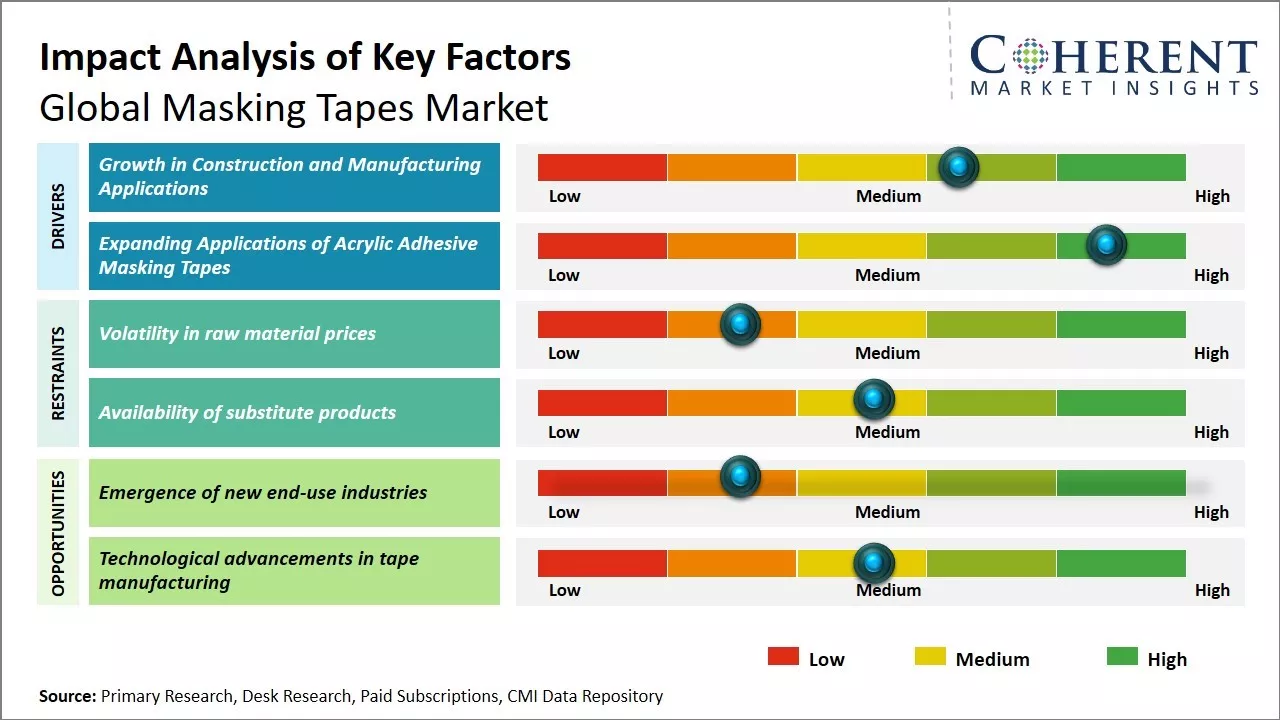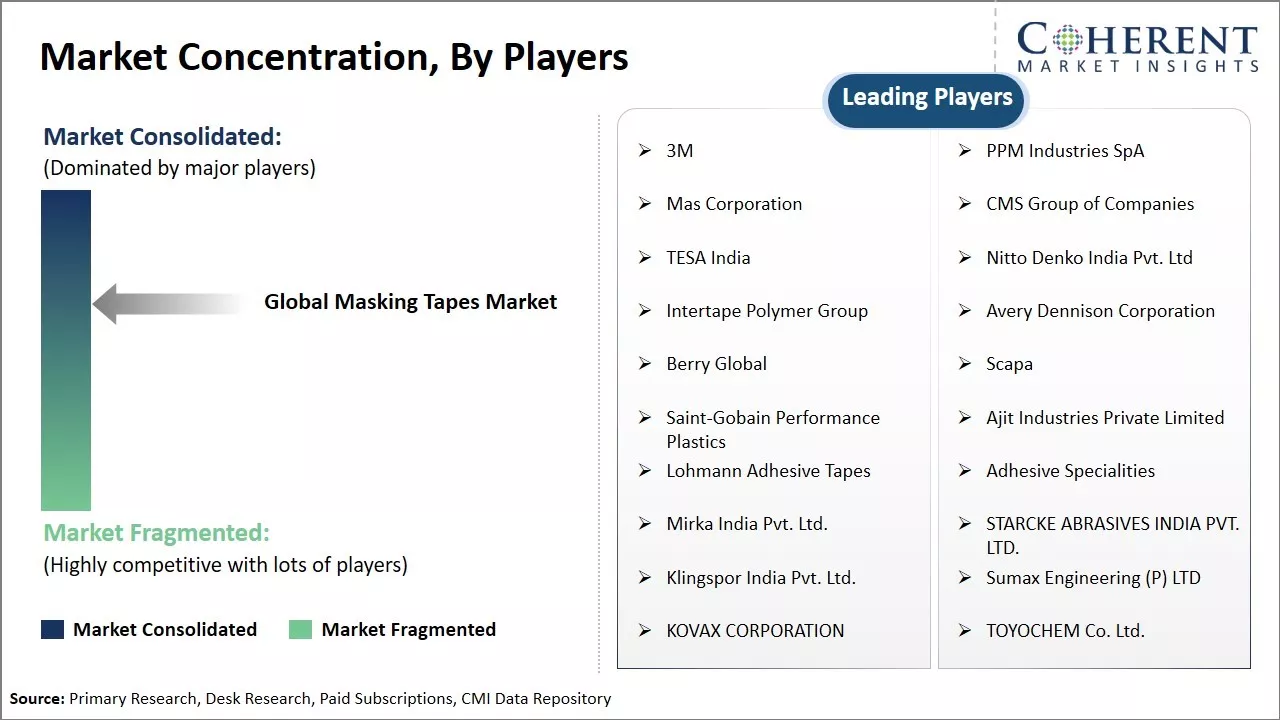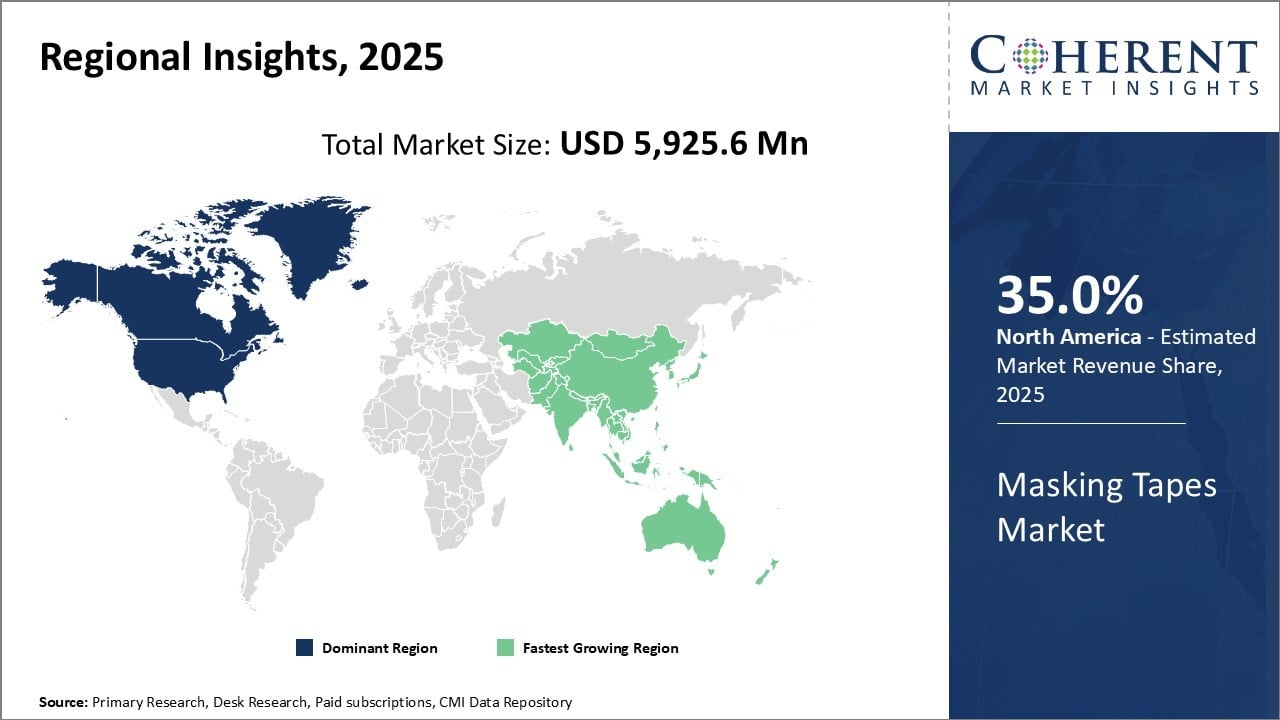The Global Masking Tapes Market size is estimated to be valued at USD 5,925.6 Mn in 2025 and is expected to reach USD 8,232.9 Mn by 2032, growing at a compound annual growth rate (CAGR) of 4.8% from 2025 to 2032.

To learn more about this report, Download Free Sample
Masking tapes are widely used across various end-use industries such as automotive, building & construction, healthcare, electronics, packaging, and others. Increased construction activities along with rapid industrialization in emerging nations of Asia Pacific and the Middle East & Africa are fueling the demand for masking tapes. The masking tapes market is expected to witness significant growth over the forecast period. Growing popularity of DIY projects among individuals is propelling the sales of masking tapes. In addition, stringent environmental regulations regarding the use of hazardous substances in masking tapes are prompting market players to introduce eco-friendly product varieties made from natural rubber, which is further supporting the market expansion. However, the availability of substitute products like painter tapes act as a challenge.
|
Event |
Description and Impact |
|
Geopolitical Tensions & Supply Chain Disruptions |
|
|
Technological Advancements & Sustainability Trends |
|
|
Industrial Expansions & Production Halts |
|
Uncover macros and micros vetted on 75+ parameters: Get instant access to report

To learn more about this report, Download Free Sample
Masking tapes are widely used in these sectors for marking, binding, and packaging materials. According to the World Bank, the construction sector grew by 3.6% in 2021, driven by infrastructure and residential construction spending in large economies. These masking tapes are also needed to mark the bridges, highways, metros, and rail networks the government plans to build. Some reports of the United Nations Industrial Development Organization also mention that the global manufacturing output increased by approximately 6% in 2021 over the previous year.
There has been an increase in the usage of masking tapes partially because of the accelerated recovery in manufacturing from the pandemic slump and partly because of new category expansions. Within manufacturing, the automotive and electronics sectors have assembly lines that depend on masking tapes for surface protection, joining, and holding during pre-treatment, painting, and component fitting processes.
The flourishing automotive and electronics manufacturers in the Asia Pacific region are especially large consumers of specialized tape solutions. Construction and manufacturing sectors are anticipated to largely maintain their steady growth path over the next several years. National infrastructure development programs and smart city project investments will sustain spending on construction. At the same time, policies focused on local manufacturing as well as new trade agreements will expand production volumes globally. Such persistent growth of industries around the world will increase the consumption of masking and protective tapes and consequently boost the global masking tape market in the long run.
In recent years, the global masking tapes market has seen strong development due to the increased usage of acrylic adhesive masking tapes in various industrial sectors. These tapes are widely utilized in the automotive, building & construction, and general industrial activities where protection from spills of paints, primers, and other finishings is required. In the automotive sector, acrylic masking tapes are becoming widely accepted for masking various body parts, trims, and emblems of vehicles during the painting processes. Their popularity has been boosted by strong adhesion and easy removability without residue. According to OICA, automotive production increased more than 4% globally in 2021 compared to 2020. The increasing production schedules suggested by OICA are expected to increase the demand for masking tapes from automotive OEMs and body shops for many years to come. In building & construction, acrylic tapes are also widely used for masking off doors, windows as well as flooring during painting and renovation works.
According to data from the United Nations Environment Programme (UNEP), the global construction sector is expected to grow by more than 85% between 2016 and 2030, largely fueled by China, the US, and India. This growth in construction expenditures bodes well for sustained demand rise from associated end-use industries like paints, coatings, and masking tapes over the coming decade.
The global masking tapes market is poised for a leap in growth due to the emergence of new end-use industries. Advancements in technology are creating new sectors that need specialized masking tapes for a variety of applications. One area that holds great promise is renewable energy. As we invest more in solar, wind, geothermal, and green hydrogen due to climate change and fossil fuel reliance, these sectors are growing rapidly. The global expansion of wind and solar PV energy reached unprecedented levels in 2020, and according to the IEA’s 2021 report, these trends are expected to continue well into the future. Masking tapes are extensively used to section off parts, create temporary bonds, and protect surfaces during treatment and assembly for the manufacture and installation of renewable energy infrastructure.
In terms of type, single side is expected to contribute 61.7% share of the masking tapes market demand owing to its convenience of use and cost effectiveness in 2025. Single side tapes have adhesive only on one side which makes them simple to use even for semi-skilled workers. This ease of application reduces the labor costs associated with the task.
Since the adhesive is present on only one side, the amount of adhesive used is minimal, keeping production costs to a minimum. This allows Single Side tapes to retain their affordability even in mass production and assembly line settings. The low price and convenience of one-sided adhesive properties has made single side tapes the go to option for basic masking requirements across various industries.
In terms of adhesive type, rubber-based adhesive is expected to contribute 36.1% of the masking tapes market share owing to its superior bonding strength in 2025. Rubber-based adhesives are capable of forming incredibly rigid bonds which are able to withstand harsh external conditions like heat, moister, chemicals and so on.
This is especially important for processes such as finishing, painting or wrapping where the tape is needed to hold edges firmly during the process. The strong yet flexible bonds offered by rubber-based formulations help in preventing paint bleed, protecting surfaces and ensuring a clean finish. These properties make the adhesive useful for various industries, and also for home projects.
In terms of backing material, foam contributes 33% share of the masking tapes market value due to its ability to conform to intricate surfaces in 2025. Foam backed tapes easily mold to the underlying substrate contours without bridging or forming air pockets. This conformal contact allows the tape to achieve strong adhesion even on rough, curved, or complex surfaces that other materials cannot adhere to well.
The conformable nature suits automotive, construction, and special surface applications. It is especially useful while masking complex contours in applications such as graphics, surface coating, etc. Foam tapes thus see heightened demand wherever uniform, defect-free finishes are required on intricate, imperfect surfaces.

To learn more about this report, Download Free Sample
North America is expected to dominate the global masking tapes market with a 35.0% share in 2025, driven by a strong industrial base across automotive, building & construction, and general manufacturing sectors. The U.S. and Canada are key contributors, owing to the presence of major OEMs and component manufacturers that utilize masking tapes extensively in automotive production, shipbuilding, and aerospace applications.
Furthermore, the region benefits from continuous innovation by leading manufacturers in developing advanced product types, such as foil masking tapes, low-noise variants, and ultra-high bond (UHB) tapes. While innovation and industry demand remain strong, market expansion could face headwinds from fluctuating raw material costs and environmental regulations on adhesive formulations.
Asia Pacific is projected to be the fastest growing region in the global masking tapes market trend in 2025, supported by rapid industrialization and urban development across major economies such as China, India, and Indonesia. The surge in construction activities and automotive manufacturing is fueling regional demand.
Additionally, increasing per capita income and the growing popularity of DIY home improvement trends are boosting sales of consumer-grade masking tapes. Regional manufacturers benefit from shorter product development cycles and cost-effective production, enabling them to introduce tailored solutions for emerging needs. Efforts by global brands to strengthen local sourcing and distribution networks are further contributing to the region’s growth momentum.
The U.S. leads the North American masking tapes market due to its well-established automotive and aerospace manufacturing sectors. A mature industrial landscape and strong presence of global and domestic masking tape producers support consistent demand. Product innovation aimed at durability, thermal resistance, and specialty applications continues to shape market competitiveness, although environmental regulations on adhesive components remain a critical factor influencing product strategies.
India is emerging as a high-potential market in Asia Pacific’s masking tapes segment, fueled by expanding automotive production, infrastructure development, and consumer interest in DIY products. Government-led initiatives to boost domestic manufacturing and construction, alongside rising disposable incomes, are accelerating demand across industrial and residential sectors. Local manufacturers are increasingly focusing on innovation and cost efficiency to cater to a broadening customer base.
| Report Coverage | Details | ||
|---|---|---|---|
| Base Year: | 2024 | Market Size in 2025: | USD 5,925.6 Mn |
| Historical Data for: | 2020 To 2024 | Forecast Period: | 2025 To 2032 |
| Forecast Period 2025 to 2032 CAGR: | 4.8% | 2032 Value Projection: | USD 8,232.9 Mn |
| Geographies covered: |
|
||
| Segments covered: |
|
||
| Companies covered: |
3M , PPM Industries SpA, Mas Corporation, CMS Group of Companies, TESA India, Nitto Denko India Pvt. Ltd, Intertape Polymer Group, Avery Dennison Corporation, Berry Global, Scapa , Saint-Gobain Performance Plastics, Ajit Industries Private Limited, Lohmann Adhesive Tapes, Adhesive Specialities, Mirka India Pvt. Ltd., STARCKE ABRASIVES INDIA PVT. LTD., Klingspor India Pvt. Ltd., Sumax Engineering (P) LTD, KOVAX CORPORATION, and TOYOCHEM Co. Ltd. |
||
| Growth Drivers: |
|
||
| Restraints & Challenges: |
|
||
Uncover macros and micros vetted on 75+ parameters: Get instant access to report
*Definition: The global masking tapes market involves the sales of various types of masking tapes that are used for masking and protecting surfaces during painting, finishing, or other surface preparation processes. Masking tapes are made up of a thin and easy-to-tear paper or plastic carrier material coated with a pressure-sensitive adhesive. They are available in various sizes and are used across industries like automotive, building & construction, aerospace, and others.
Share
Share
About Author
Vidyesh Swar is a seasoned Consultant with a diverse background in market research and business consulting. With over 6 years of experience, Vidyesh has established a strong reputation for his proficiency in market estimations, supplier landscape analysis, and market share assessments for tailored research solution. Using his deep industry knowledge and analytical skills, he provides valuable insights and strategic recommendations, enabling clients to make informed decisions and navigate complex business landscapes.
Missing comfort of reading report in your local language? Find your preferred language :
Transform your Strategy with Exclusive Trending Reports :
Frequently Asked Questions
Joining thousands of companies around the world committed to making the Excellent Business Solutions.
View All Our Clients